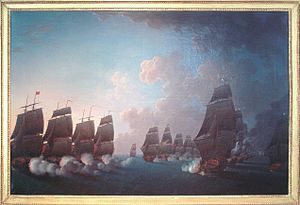
Luc Urbain du Bouëxic, comte de Guichen was a French admiral who commanded the French fleets that fought the British at the First Battle of Ushant (1778) and the Battle of Martinique (1780) during the American War of Independence.

The Battle of the Saintes, also known as the Battle of Dominica, was an important naval battle in the Caribbean between the British and the French that took place 9–12 April 1782. The British victory was considered their greatest over the French during the American Revolutionary War.

The Battle of Grenada took place on 6 July 1779 during the American Revolutionary War in the West Indies between the British Royal Navy and the French Navy, just off the coast of Grenada. The British fleet of Admiral John Byron had sailed in an attempt to relieve Grenada, which the French forces of the Comte D'Estaing had just captured.

The Battle of Fort Royal was a naval battle fought off Fort Royal, Martinique in the West Indies during the Anglo-French War on 29 April 1781, between fleets of the British Royal Navy and the French Navy. After an engagement lasting four hours, the British squadron under Admiral Samuel Hood broke off and retreated. Admiral de Grasse offered a desultory chase before seeing the French convoys safe to port.

The Battle of St. Lucia or the Battle of the Cul de Sac was a naval battle fought off the island of St. Lucia in the West Indies during the American Revolutionary War on 15 December 1778, between the British Royal Navy and the French Navy.
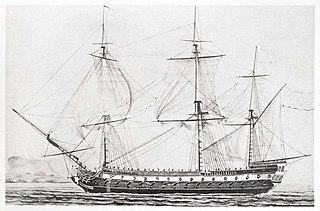
Triomphant was an 80-gun ship of the line of the French Navy.
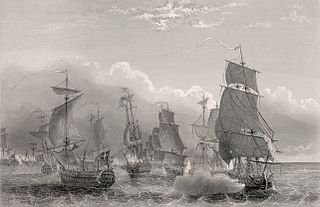
The Battle of Martinique, or Combat de la Martinique, was a naval encounter on 18 December 1779 between a British 13-ship squadron under Admiral Hyde Parker and a three-ship French division under Admiral Lamotte-Picquet near the island of Martinique in the West Indies.
Caton was a 64-gun ship of the line of the French Navy, launched in 1777.
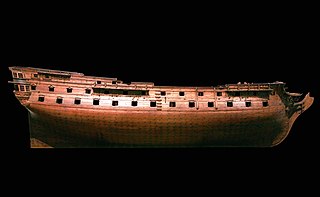
The Vengeur was a 64-gun ship of the line of the French Navy designed by Antoine Groignard. She saw action with Bailli de Suffren during the American War of Independence.
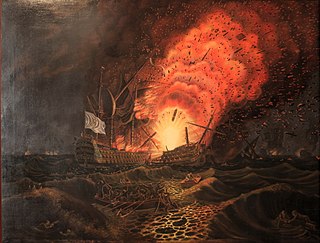
César was a 74-gun ship of the French Navy. Ordered in the spring of 1767 from the Toulon shipyard, she was launched on 3 August 1768. César saw service in the American War of Independence, during which she was destroyed in the Battle of the Saintes.

The Anglo-French War, also known as the War of 1778 or the Bourbon War in Britain, was a military conflict fought between France and Great Britain, sometimes with their respective allies, between 1778 and 1783. As a consequence, Great Britain was forced to divert resources used to fight the American War of Independence to theatres in Europe, India and the West Indies, and to rely on what turned out to be the chimera of Loyalist support in its North American operations. From 1778 to 1783, with or without their allies, France and Britain fought over dominance in the English Channel, the Mediterranean, the Indian Ocean and the Caribbean.
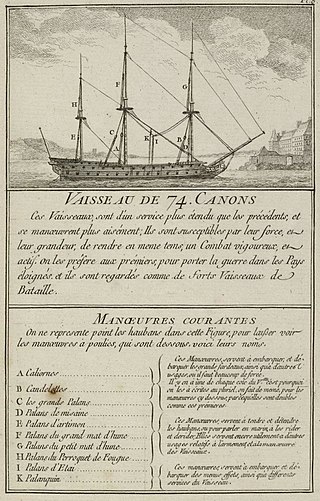
Palmier was a 74-gun ship of the line of the French Navy.

Louis Charles du Chaffault de Besné was a French Navy officer. He notably took part in the Second Battle of Cape Finisterre in 1747, and was one of the commanders at the Battle of Ushant on 27 July 1778.He also lead the Larache expedition

Robuste was an 74-gun ship of the line of the French Navy, built by Antoine Groignard.

Louis Guillaume de Parscau du Plessix was a French Navy officer. He served in the War of American Independence, earning membership in the Society of the Cincinnati.
Indien was a 64-gun ship of the line of the French Navy, lead ship of her class. Originally built for the French East India Company, she was purchased by the Navy and saw service during the War of American Independence
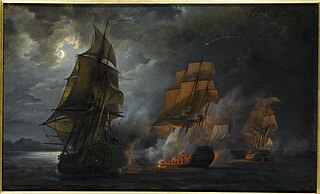
Triton was a 64-gun ship of the line of the French Navy designed by François Coulomb the Younger. She took part in the Seven Years' War and in the War of American Independence.
Zodiaque was a 74-gun Diadème-class ship of the line of the French Navy.
Hippolyte-Augustin de Sade de Vaudronne was a French Navy officer. He served during the War of American Independence.

Armand-Claude Poute de Nieuil was a French Navy officer. He served during the War of American Independence.
